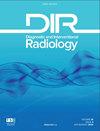Effectiveness of the diagnostic pathway of BLES: could it be safely used as a therapeutic method in selected benign lesions?
IF 2.1
4区 医学
Q2 Medicine
引用次数: 2
Abstract
PURPOSE In this study, we aimed to investigate the breast lesion excision system (BLES) as a tool and a practical alternative technique to surgical biopsy and other percutaneous biopsy methods for suspicious lesions. We also wanted to share our initial experience with BLES and compare it with standard percutaneous biopsy methods. METHODS From July 2015 to December 2016, a total 50 patients who had high-risk lesions which were diagnosed with core needle biopsy (CNB) or had lesions with radiology pathology discordance, or had high-risk factors, high-grade anxiety, or suspicious follow-up lesions were enrolled in the study. These lesions were classified as Breast Imaging Reporting and Data System (BI-RADS) 3 or 4, which are under 2 cm. Pathologic diagnoses before and after BLES were evaluated comparatively. The diagnostic and therapeutic success and the complications of CNB and BLES were analyzed. RESULTS After BLES, two cases were diagnosed as atypical lobular hyperplasia and atypical ductal hyperplasia. Since the surgical margin was negative, re-excision was not required. Two cases were diagnosed as malignant, and no residual tissue was detected in the operation region. Total excision rates were reported as 56%. Minor hematoma was observed in only 1 out of 50 cases (2%), and spontaneous remission was observed. Two patients (4%) complained of pain during the procedure. Radiofrequency-related thermal damage to the specimen showed: Grade 0 (<0.5 mm) damage in 88%, Grade 1 (0.5-1.5 mm) in 10%, Grade 2 (>1.5 mm or thermal damage in diffuse areas) in 2%, and Grade 3 (diffuse thermal damage or inability to diagnose) in 0%. We found a significant positive correlation between classification of thermal damage and lesion fat cell content (r = 0.345, P = 0.015). CONCLUSION BLES is a safe technique that can be effectively used with low complication rates in the excision of benign and high-risk breast lesions in selected cases. It may also provide high diagnostic success and even serve as a therapeutic method in high-risk lesions, such as radial scar, papilloma, and atypical lobular hyperplasia with high complete excision rates without fragmentation of lesions.BLES诊断途径的有效性:它能安全地用作选定良性病变的治疗方法吗?
目的在本研究中,我们旨在研究乳腺病变切除系统(BLES)作为一种工具和一种实用的替代技术,以替代外科活检和其他经皮活检方法来治疗可疑病变。我们还想分享我们使用BLES的初步经验,并将其与标准经皮活检方法进行比较。方法自2015年7月至2016年12月,共有50名经核心针活检(CNB)诊断为高危病变或放射学病理不一致病变,或有高危因素、高度焦虑或可疑随访病变的患者参与研究。这些病变被分类为乳腺影像学报告和数据系统(BI-RADS)3或4,它们在2cm以下。比较BLES前后的病理诊断。分析CNB和BLES的诊断和治疗成功率以及并发症。结果BLES诊断为不典型小叶增生和不典型导管增生2例。由于手术切缘为阴性,因此不需要再次切除。两例被诊断为恶性肿瘤,手术区域未发现残留组织。据报道,总切除率为56%。在50例病例中只有1例(2%)观察到轻微血肿,并观察到自发缓解。两名患者(4%)在手术过程中抱怨疼痛。样本的射频相关热损伤显示:2%为0级(1.5 mm或弥漫性区域的热损伤),0%为3级(弥漫性热损伤或无法诊断)。我们发现热损伤的分类与病变脂肪细胞含量之间存在显著的正相关(r=0.345,P=0.015)。结论在选定的病例中,在切除良性和高危乳腺病变时,BLES是一种安全、并发症发生率低的技术。它还可以提供高诊断成功率,甚至可以作为高危病变的治疗方法,如桡骨瘢痕、乳头状瘤和不典型小叶增生,完全切除率高,病变不碎裂。
本文章由计算机程序翻译,如有差异,请以英文原文为准。
求助全文
约1分钟内获得全文
求助全文
来源期刊
CiteScore
3.50
自引率
4.80%
发文量
69
审稿时长
6-12 weeks
期刊介绍:
Diagnostic and Interventional Radiology (Diagn Interv Radiol) is the open access, online-only official publication of Turkish Society of Radiology. It is published bimonthly and the journal’s publication language is English.
The journal is a medium for original articles, reviews, pictorial essays, technical notes related to all fields of diagnostic and interventional radiology.

 求助内容:
求助内容: 应助结果提醒方式:
应助结果提醒方式:


